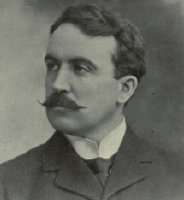Hance James Logan
| The Hon. Hance James Logan | |
|---|---|
 | |
| Senator for Cumberland, Nova Scotia | |
|
In office February 5, 1929 – December 26, 1944 | |
| Appointed by | William Lyon Mackenzie King |
| Member of the Canadian Parliament for Cumberland | |
|
In office 1896–1911 | |
| Preceded by | Arthur Rupert Dickey |
| Succeeded by | Edgar Nelson Rhodes |
|
In office 1921–1925 | |
| Preceded by | Edgar Nelson Rhodes |
| Succeeded by | Robert Knowlton Smith |
| Personal details | |
| Born |
April 26, 1869 Amherst Point, Nova Scotia |
| Died |
December 26, 1944 (aged 75) Ottawa, Ontario[1] |
| Political party | Liberal |
Hance James Logan, KC (April 26, 1869 – December 26, 1944) was a Canadian lawyer and politician.[2]
Born in Amherst Point, Nova Scotia,[2] the son of James Archibald Logan, he was educated at the Model School of Truro, the Pictou Academy and Dalhousie University where he graduated with a Bachelor of Laws (LL.B.) in 1891.[3] He was called to the Nova Scotia bar in 1892 and practised law in Amherst. In 1909, he was named King's Counsel.[1]
Logan was first elected to the Canadian House of Commons for the electoral district of Cumberland on June 23, 1896, by a majority of 155 votes, defeating Arthur Rupert Dickey, the Minister of Justice in the Charles Tupper Government. A Liberal, he was re-elected in 1900 and 1904. He was defeated in 1911 and 1917. He was re-elected in 1921 and was defeated in 1925. In 1929, he was summoned to the Senate of Canada representing the senatorial division of Cumberland, Nova Scotia on the advice of William Lyon Mackenzie King. He served until his death in 1944.[2]
He was married twice: to Eleanor L. Kinder in 1891 and then to Anna Blanche MacKenna in 1921.[1]
References
- 1 2 3 Johnson, J.K. (1968). The Canadian Directory of Parliament 1867-1967. Public Archives of Canada.
- 1 2 3 Hance James Logan – Parliament of Canada biography
- ↑ The Canadian Parliament; biographical sketches and photo-engravures of the senators and members of the House of Commons of Canada. Being the tenth Parliament, elected November 3, 1904